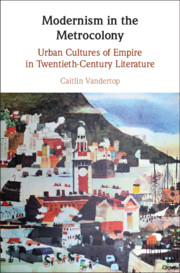Book contents
- Modernism in the Metrocolony
- Modernism in the Metrocolony
- Copyright page
- Contents
- Acknowledgements
- Introduction The Colonies in Concrete
- Chapter 1 Metrocolonial Modernism
- Chapter 2 Architectures of Free Trade in Conrad’s Singapore
- Chapter 3 Synchronising Empire Time in Joyce’s Dublin
- Chapter 4 Anglo-Indian Crises of Development
- Chapter 5 Ecologies of Empire in Oceanian Modernism
- Conclusion Mega-Dublins
- Notes
- Bibliography
- Index
Chapter 3 - Synchronising Empire Time in Joyce’s Dublin
Published online by Cambridge University Press: 05 November 2020
- Modernism in the Metrocolony
- Modernism in the Metrocolony
- Copyright page
- Contents
- Acknowledgements
- Introduction The Colonies in Concrete
- Chapter 1 Metrocolonial Modernism
- Chapter 2 Architectures of Free Trade in Conrad’s Singapore
- Chapter 3 Synchronising Empire Time in Joyce’s Dublin
- Chapter 4 Anglo-Indian Crises of Development
- Chapter 5 Ecologies of Empire in Oceanian Modernism
- Conclusion Mega-Dublins
- Notes
- Bibliography
- Index
Summary
This chapter highlights the formative impact of colonial urbanism on the ‘high’ modernist aesthetics of the 1920s, focusing on the role of Dublin in the work of James Joyce. In Dublin, imperial ideals of unity, equalisation and harmony were inscribed onto the architectural landscape and crystallised in early twentieth-century British philanthropic discourses. This chapter focuses on the Empire Day movement, whose organisers aimed to inspire pride and participation in colonial subjects through a day-long urban celebration. While this event attempted to synchronise time across the empire’s cities, as part of an early Commonwealth imaginary, Joyce’s ‘Wandering Rocks’ episode from Ulysses confronts readers with experiences of dissonance and asynchronism, just as the temporality of the episode itself resists readerly synchronisation.
- Type
- Chapter
- Information
- Modernism in the MetrocolonyUrban Cultures of Empire in Twentieth-Century Literature, pp. 76 - 94Publisher: Cambridge University PressPrint publication year: 2020

